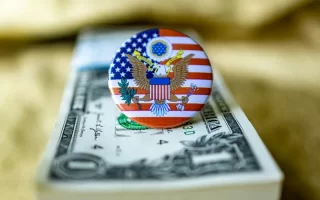The S&P 500 futures are down 2%, and the dollar is losing value against other currencies. Other stocks are also affected and are trending down, and it seems that global trade dynamics are heavily impacted as well. This is primarily caused by the current US President Donald Trump’s sweeping reciprocal tariffs against almost all countries in the world that started on April 2, which took full effect on April 5.
Along with this, the US dollar is struggling. Many economists and political leaders are continually questioning the US’s current moves and the dollar’s status as a safe investment.
In this situation, investors, as well as the average person and people abroad, feel uneasy about holding dollars. This has led to a preference for other currencies like the Japanese Yen (JPY) and Swiss Franc (CHF), as well as gold, which are seen as more stable and safe investments.
However, some investors and most supporters of the current decisions of the White House believe that this is an opportunity to invest in US dollars and US companies. They think it’s a good time to buy US dollars and stocks, as they are optimistic that their value will regain and even surpass the levels seen prior to President Trump’s imposition of reciprocal tariffs.
On April 9, the president issued a 90-day pause on tariffs, setting most at a baseline of 10%, with some exceptions for pharmaceuticals, lumber, auto, aluminum, and steel—products that Donald Trump is focused on bringing back to US production.
This decision was presumably influenced by 75 countries and their leaders seeking deals with the United States, as well as concerns from top economists and investors. However, China was an exception, facing a 125% tariff on all its goods due to its retaliatory response to the initial tariffs.
What Is The S&P 500 Futures
The S&P (Standard and Poor’s) 500 futures are financial contracts that allow investors to speculate on the future value of the S&P 500 index, which measures the performance of 500 of the largest publicly traded companies in the United States.
Essentially, the S&P 500 index serves as a key indicator of the US economy. If the top 500 companies are not performing well, it can significantly impact the country’s income and overall economic health, and vice versa.
What Is A Weakened Dollar
A weakened dollar refers to a decline in the value of the US dollar compared to other currencies. This depreciation can occur due to various economic, political, and market factors, and it has significant implications for both domestic and international economic conditions.
For example, consider that you have a net worth of $1,000,000, while a Japanese man has a net worth of ¥150,000,000. If the exchange rate between the USD and JPY is 1:150, both you and the Japanese man have the same net worth, equivalent to ¥150,000,000.
However, if the dollar weakens and the exchange rate changes to 1:125, your net worth in Japanese yen would be ¥125,000,000. In this scenario, you would be approximately 16.67% poorer than the Japanese man without you having any say on it.
Of course, the value of the dollar fluctuates constantly due to the factors mentioned. However, if this depreciation continues for an extended period, it may take a long time for the dollar to recover to its original value, which means that your money will continue to depreciate as well.
How Does The Weakened Dollar Affect Business
The sudden downturn of the stock market isn’t new, as it regularly experiences highs and lows. Additionally, it’s not the only economic indicator that reflects the country’s financial health and the state of business.
However, prolonged bearish trends in the stock market and continued weakening of the dollar can create significant impacts on businesses, both positive and negative.
For example, a continued drop in the dollar can erode trust among US and foreign investors, leading to decreased foreign investment, which is essential for funding the US’s large annual deficit. This could result in higher borrowing costs and increased economic pressure.
While domestic investments may lose value compared to global standards, US companies with significant international operations could benefit, as their goods and services become cheaper for foreign buyers, potentially increasing their sales.
On the flip side, this continued downward trend can cause businesses to perceive market volatility in the US. When this happens, companies may prepare to abandon ship and try to save their business by relocating to another country with a much more stable economic and business environment.
How Does The Weakened Dollar Affect Us In The Short Run
A weak dollar reduces the perceived value of money. While a crash in the US stock market and a weakened dollar often go unnoticed by the average person, they can lead to rising inflation.
Do note that the annual inflation rate is at 2.4%, with a monthly decline of 0.1%, according to the US Labor Department for March 2025. This rate will be updated on May 13 to reflect recent events. However, it does not account for the effects of the recent tariff strategies imposed by the president.
Investors and traders feel the impact of a weakened dollar immediately, as their investments in US assets may decrease in value. However, US companies with significant international sales could benefit, as their products become more competitively priced abroad.
However, risk takers and optimists can gamble their money on the falling stocks and currency value. When the dollar’s power normalizes or improve, they will gain significant gains on their investments.
Additionally, those traveling or working outside the US may find their dollars exchange for less local currency, increasing their expenses overseas.
How Does The Weakened Dollar Affect The US In The Long Run
A prolonged drop in the value of the US dollar can have significant effects on the nation’s economy. While some areas might see short-term benefits, the long-term consequences often create challenges:
- A weaker dollar makes imported goods and services more expensive, leading to higher prices for consumers and contributing to overall inflation. If tariffs resume and increase, import prices will rise even further.
- The decline in the dollar’s value diminishes the real purchasing power of savings and fixed-income assets.
- Changes in the dollar’s value can affect retirement savings, particularly for those heavily invested in US stocks and bonds. A weaker dollar may lead to lower returns on these investments, hindering the growth of retirement funds.
Basically, it will be a disaster. However, this is a pessimistic prediction of what could happen if the stock market continues to crash and the dollar continues to weaken. Currently, inflation, the stock market, and the dollar’s value are not as low as they were during the pandemic, which marked the lowest point in a decade.
If the countries seeking a deal with the White House reach agreements for zero tariffs, it is predicted that the stock market and the dollar’s value will bounce back.
Key Points
- Impact of Tariffs on the Dollar: The US dollar is struggling due to President Trump’s sweeping reciprocal tariffs imposed on many countries, which has led to a decline in the dollar’s value and increased uncertainty among investors.
- Investor Sentiment: Many investors and the general public are uneasy about holding dollars, leading to a preference for more stable currencies like the Japanese Yen and Swiss Franc, as well as gold. However, some see this as an opportunity to invest in US dollars and companies, believing their value will recover.
- Short-Term and Long-Term Effects: In the short run, a weakened dollar can lead to rising inflation and decreased purchasing power for consumers. In the long run, it can result in higher import costs, reduced savings value, and potential challenges for retirement funds.
- Market Volatility and Business Decisions: A continued decline in the dollar can erode trust among investors, leading to decreased foreign investment and higher borrowing costs. This volatility may prompt businesses to consider relocating to countries with more stable economic environments.
- Potential for Recovery: If countries negotiating with the US reach agreements for zero tariffs, it is predicted that both the stock market and the dollar’s value could bounce back, alleviating some of the current economic pressures and giving the US economy a bullish comeback.






